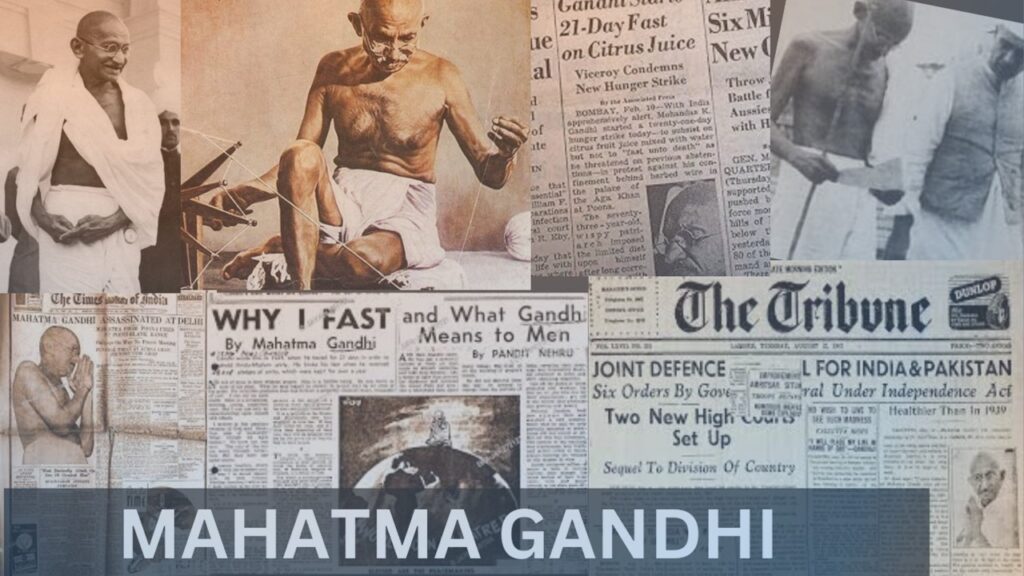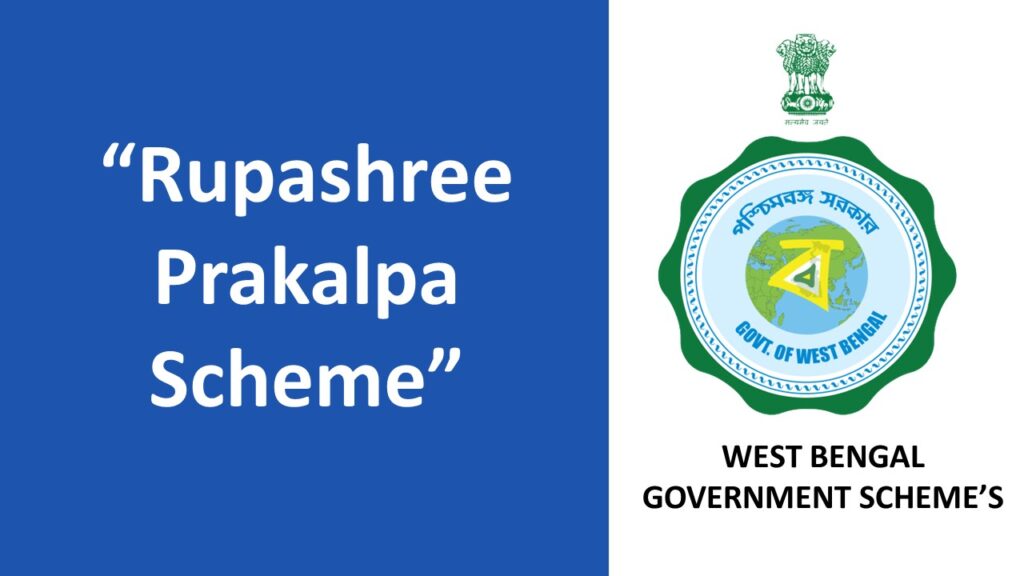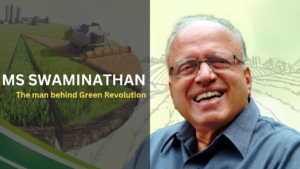Mahatma Gandhi was a well known freedom activist and a formidable political figure. His significant role in India’s non-violent struggle for independence from British rule ultimately led to India’s liberation. He was affectionately known as the Father of India, Bapu (a term of endearment for father), and Mahatma (meaning Great Soul). Gandhi also dedicated himself to uplifting the lives of India’s impoverished and marginalized communities. His steadfast commitment to truth and non-violence left a lasting impact on many, including figures like Martin Luther and Nelson Mandela. Gandhi’s diverse roles included that of a lawyer (having studied law in London in 1888), a political activist, and a writer.
Mahatma Gandhi stands as the paramount figure of the Indian independence struggle, and his legacy continues to be a beacon of inspiration worldwide. This post delves into Gandhi’s biography, family, education, life journey, philosophical principles, memorable quotes, and more. Commonly referred to as Mahatma Gandhi, his birth name was Mohandas Karamchand Gandhi. Besides his pivotal role in India’s quest for independence, Gandhi was a lawyer, a devoted nationalist, and an anti-colonial activist. He spearheaded a non-violent mass movement against the British colonial rule in India, eventually leading to the nation’s freedom.
In India, Mahatma Gandhi holds an exalted status and is affectionately known as the Father of the Nation. His life serves as an enduring lesson, and his ideals continue to inspire countless individuals worldwide.
Mahatma Gandhi Biography
In a small town named Porbandar in present-day Gujarat, India he was born on October 2, 1869. His early years in this Vaisya caste family, traditionally associated with merchants and traders, significantly influenced his values and future path. His father, Karamchand Gandhi, held the position of Dewan (Chief Minister) in Porbandar, which was then a princely state under British colonial rule.
Gandhi’s mother, Putlibai, was a religious woman from whom Gandhiji got a strong sense of spirituality and morality. Her influence on his upbringing established the groundwork for his later commitment to truth and nonviolence.
| Particulars | Details |
| Mahatma Gandhi birthday | He was born on 2nd October 1869 at Porbandar, Gujarat |
| Mahatma Gandhi full name | Mohandas Karamchand Gandhi |
| Mahatma Gandhi father name | Karamchand Gandhi |
| Mahatma Gandhi Mothers Name | Putlibai Gandhi |
| Mahatma Gandhi wife name | Kasturba Gandhi |
| Mahatma Gandhi children | Harilal, Manilal, Ramdas. Devdas |
| Mahatma Gandhi books | Autobiography: The Story of My Experiments with Truth Hind Swaraj or Indian Home Rule |
| Mahatma Gandhi slogan | “Do or Die” “Nonviolence is a weapon of the strong” “Be the change that you want to see in the world” “In a gentle way, you can shake the world” |
| Mahatma Gandhi death | 30th January, 1948 |
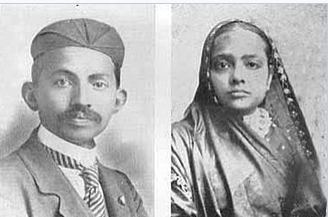
At the age of 13, Gandhi entered an arranged marriage with Kasturba Makhanji, also known as Kasturba Gandhi, as was customary in Indian society of that era. Kasturba would not only be his wife but also an unwavering companion in his social and political journey.
Gandhi’s early exposure to Hindu scriptures, tales of moral rectitude, and his family’s emphasis on truth and ethical living left an indelible mark on him. These principles played a pivotal role in the development of his philosophy of nonviolent resistance, which he later termed as Satyagraha.

Mahatma Gandhi Signature
Education of Mahatma Gandhi
Mahatma Gandhi’s early education commenced at a school in Rajkot, where he delved into subjects like history, geography, arithmetic, and languages. Later, he transitioned to a higher-level institution within Rajkot. However, his educational journey experienced interruptions due to his marriage. Nevertheless, he persisted and eventually resumed his studies. In 1888, he took admission at Samaldas College in Bhavnagar.
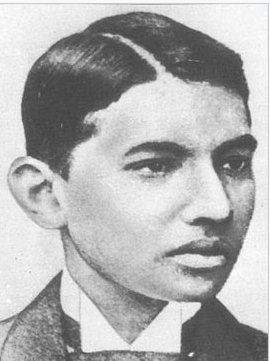
Despite pursuing a college education, Gandhi found himself unsatisfied with the academic path he was on. Driven by his convictions, he managed to persuade his parents to support his aspirations and obtained their consent to journey to London to study Law. Before embarking on this journey, he solemnly pledged to his family that he would uphold certain ethical principles: he would refrain from consuming non-vegetarian food, engaging in inappropriate interactions with women, and indulging in alcohol.
Upon his arrival in London, Gandhi enrolled at Inner Temple Law College to pursue his legal studies. Alongside his academic pursuits, he became a member of a vegetarian society, connecting with like-minded individuals who shared his dietary preferences and ethical values. During this period, Gandhi’s affiliation with this society introduced him to the Bhagavad Gita, a revered Hindu scripture. The teachings of the Bhagavad Gita had a profound impact on him, shaping his perspective on life, spirituality, and nonviolent principles.
The influence of the Bhagavad Gita became a guiding force in Gandhi’s life, contributing to the formation of his philosophy of nonviolence (ahimsa) and his unwavering commitment to truth and morality. His time in London marked a significant period of personal growth and philosophical exploration, laying the foundation for his future role as a leader in India’s struggle for independence, as well as his advocacy for civil rights and social justice
Mahatma Gandhi’s Important Books
Mahatma Gandhi penned numerous books and writings that encapsulate his philosophies, beliefs, and ideals. Some of his pivotal works encompass:
- Autobiography: The Story of My Experiments with Truth: This autobiography stands as one of Gandhi’s most renowned works. Here, he chronicles his life, experiences, and the evolution of his principles, including his trials with truth and nonviolence. The book offers a glimpse into his personal challenges, convictions, and his role in India’s struggle for independence.
- Hind Swaraj or Indian Home Rule: Published in 1909, this book delves into the notions of self-rule and nonviolent resistance. It critiques Western civilization and its impact on India, advocating for a return to traditional Indian values and self-reliance.
- Key to Health: This book centers on Gandhi’s principles of health and hygiene, advocating for natural remedies and a modest lifestyle. He believed that physical well-being was crucial for an individual’s overall growth and spiritual development.
- Satyagraha in South Africa: This compilation of Gandhi’s writings captures his experiences and reflections during his time in South Africa. Highlighting his experiments with ideals of satyagraha (nonviolent resistance) and civil disobedience against racial discrimination.
- Constructive Programme: Its Meaning and Place: In this work, Gandhi delves into the concept of a constructive program, emphasizing positive actions for social change, including education, sanitation, economic self-sufficiency, and communal harmony.
- My Experiments with Truth (Satyana Prayogo): This is a Gujarati translation of Gandhi’s autobiography, offering readers in his native language a window into his life’s journey, values, and beliefs.
- The Bhagavad Gita According to Gandhi: This commentary by Gandhi presents his interpretations of the Bhagavad Gita, providing insights into his spiritual and philosophical perspective. It reveals how he applied the teachings of the Gita to his own life and struggles.
- Young India: Gandhi served as the editor of this weekly newspaper, using it as a platform to address a wide array of topics, spanning from social and political issues to economic concerns. The newspaper played a pivotal role in disseminating his ideas and championing civil disobedience and nonviolent resistance.
These books and writings exemplify the profound nature of Gandhi’s philosophy, his unwavering dedication to nonviolence, his critique of societal problems, and his vision for a fair and just society. They retain their relevance, continuing to inspire individuals worldwide who are passionate about instigating social change, engaging in activism, and leading lives guided by ethical principles.
Slogans by Mahatma Gandhi
Mahatma Gandhi was renowned for his impactful and motivational slogans that encapsulated his philosophy of nonviolence, civil disobedience, and the quest for justice. The slogans you referred to are, without a doubt, among his most widely recognized:
- “Do or Die”: This rallying cry urged people to wholeheartedly commit themselves to the struggle for India’s independence. It conveyed the urgency and determination needed in the face of colonial oppression.
- “In a gentle way, you can shake the world”: This phrase underscores the potency of nonviolent action in effecting substantial and enduring change, even through peaceful and gentle means.
- “Be the change that you want to see in the world”: This slogan underscores personal accountability in initiating positive change. It urges individuals to embody the values they aspire to witness in society.
- “Nonviolence is a weapon of the strong”: Gandhi asserted that nonviolence demanded immense strength and courage, dispelling the notion that it signified weakness.
Assassination of Mahatma Gandhi
“Mahatma Gandhi, a prominent leader of nonviolent resistance and a key figure in India’s fight for independence, met a tragic end on January 30, 1948. He was assassinated by Nathuram Godse, a Hindu nationalist, in New Delhi, India.
The assassination occurred at Birla House, now known as Gandhi Smriti, where Gandhi was conducting his nightly prayer meeting. As Gandhi made his way to the meeting, Godse approached him and fired three shots at close range. Despite suffering serious injuries, Gandhi’s final words were reported to be ‘Hey Ram’ (Oh God).
Nathuram Godse held deep-seated ideological differences with Gandhi. He believed that Gandhi’s political approach, especially his stance on partition and his efforts to foster harmony between Hindus and Muslims, were detrimental to the interests of Hindu nationalism and the cause of Hindu rights.
Immediately after the assassination, Godse, along with a co-conspirator, was apprehended. They stood trial, and in 1949, both were found guilty and sentenced to death and was executed on November 15, 1949.
Gandhi’s assassination sent shockwaves not only across India but also around the world. It marked the tragic conclusion of a life dedicated to nonviolence, civil rights, and social justice. Gandhi’s legacy endures, and he is revered as a global emblem of peaceful resistance and the pursuit of truth and equality.”
Emergence of Gandhi in South Africa
Mahatma Gandhi’s has a significant contributions during his visit in South Africa as South Africa was engraved with the issue of Apartheid and Racism. Emergence of Gandhiji in South Africa as a political leader and the practitioner of non-violence have been discussed below in details:
1893: Mohandas Gandhi witnessed severe racial discrimination against Asians in South Africa during his journey from Durban to Pretoria. The infamous incident occurred when he was forcibly removed from a first-class compartment by a white man at Pietermaritzburg station. Upon reaching Johannesburg, he faced further discrimination as he was denied accommodation in hotels.
These experiences compelled him to extend his stay in South Africa in order to organize Indian workers and empower them to fight for their rights. Gandhi began teaching English to the Asian population and worked to mobilize them to protest against the oppressive conditions. The struggle of Gandhiji in South Africa can be classified in to phase as – Moderate Phase and Passive Resistance Phase:
Moderate Phase of Resistance (1894-1906)
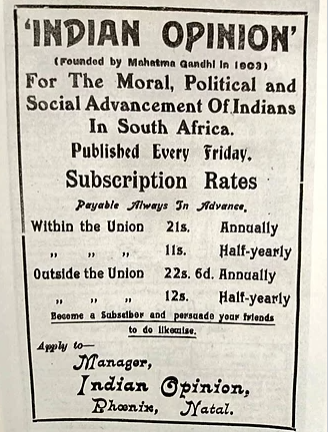
During this time, Gandhi discerned the necessity of uniting the diverse Indian community in South Africa to champion their rights. In 1894, he established the Natal Indian Congress, an organization dedicated to representing Indian interests and advancing civil rights. In order to disseminate information and rally support, Gandhi initiated a newspaper titled “Indian Opinion.”
- In 1894, after the conclusion of his Abdullah case, he decided to remain in South Africa and assist Indians in opposing a bill that aimed to strip them of their right to vote. He established the Natal Indian Congress and united the Indian community into a cohesive political force.
- From 1899 to 1902, the Boer War expanded British control to include Transvaal and Orange Free State. During this time, Gandhi volunteered to lead a group of stretcher-bearers known as the Natal Indian Ambulance Corps. This group, composed of indentured laborers, was funded by the Indian community and provided aid in treating and evacuating wounded British soldiers.
- Gandhi believed that supporting the British war efforts would help gain favor with the British imperial government and generate sympathy for the plight of Indians in South Africa. For his service, he was awarded the Queen’s South Africa Medal.
- Until 1906, the struggle for Indians in South Africa followed a moderate approach. During this period, Gandhi focused on submitting petitions and memorials to legislatures, the colonial secretary in London, and the British parliament.
Passive Resistance Phase (1906 – 1914)
Gandhi’s approach evolved to encompass passive resistance, which he termed “Satyagraha.” He encouraged Indians to oppose unjust laws and discrimination through nonviolent methods. As a part of this philosophy, he established the Tolstoy Farm, a communal living experiment where satyagrahis could embody nonviolence and self-sufficiency. Gandhi’s unwavering dedication to his principles led to his arrest and imprisonment, alongside other activists.
- In 1906, the failure of moderate methods led to the second phase of the struggle: civil disobedience or Satyagraha. Gandhi established two settlements—the Phoenix Settlement in Durban and the Tolstoy Farm in Johannesburg—to provide assistance to the needy and promote a communal way of life.
- One of his initial acts of resistance was against a government law that made it mandatory for Indians to carry identification certificates with their fingerprints at all times. Gandhi formed a Passive Resistance Association in protest. He and his followers were imprisoned. Later, the government agreed to repeal the law if Indians registered voluntarily. However, they were deceived into the registrations, leading them to protest by publicly burning their certificates.
- In 1908, the campaign expanded to protest against a new law restricting the movement of Indians between provinces. Gandhi and others were jailed and sentenced to hard physical labor.
- In 1910, Gandhi established the Tolstoy Farm in Johannesburg to prepare satyagrahis for the harsh conditions of prison, thus ensuring the continuity of the resistance.
- In 1911, Gopal Krishna Gokhale visited South Africa as a state guest during the coronation of King George V. Gokhale and Gandhi met in Durban and established a strong rapport.
- In 1913, the satyagraha continued against various oppressive laws enacted by the government. The movement against the law invalidating marriages not conducted according to Christian rites brought numerous Indian women into the fold.
Gandhiji’s Final Phase in South Africa
- Gandhi launched a final mass movement involving over 2000 men, women, and children. They were incarcerated and subjected to harsh conditions and forced labor. This prompted the entire Indian community in South Africa to go on strike.
- Meanwhile, in India, Gokhale worked to raise public awareness about the situation in South Africa. This led Viceroy Hardinge to commission an inquiry into the atrocities.
- A series of negotiations took place between Gandhiji, Viceroy Hardinge, C.R. Andrews (a Christian missionary and Indian Independence activist), and General Smuts of South Africa. This ultimately led to the government conceding to most of the Indians’ demands.
Gandhi’s unwavering endeavors, which included protests and negotiations, resulted in noteworthy accomplishments. Through a step-by-step dialogue process, an agreement was reached with the government that addressed key concerns of the Indian community. The government committed to adopting a more lenient stance on immigration and acknowledged several demands put forth by the Indian community.
Gandhi’s time in South Africa marked a period of transformative experiences that profoundly influenced his philosophy of nonviolent resistance and civil disobedience. The methods and principles he developed during these years would later play a pivotal role in India’s quest for independence and continue to serve as a source of inspiration for social justice movements around the world.
Return of Mahatma Gandhi in India
Mahatma Gandhi’s return to India and his pivotal role in the Indian National Movement are crucial chapters in history:
- Return on Gokhale’s Urging: Gandhi’s return was prompted by the counsel of Gopal Krishna Gokhale, a senior figure in the Indian National Congress and a mentor to Gandhi. It was C.F. Andrews, also known as Deenbandhu, who conveyed Gokhale’s request to Gandhi in South Africa, urging him to join the Indian struggle for freedom.
- The Gandhian Era of Indian National Movement: Gandhi’s return marked the commencement of the “Gandhian era” of the Indian National Movement. This phase is characterized by the widespread adoption of his principles of nonviolence, truth, and civil disobedience in the fight against British colonial rule.
- Leadership and Nonviolent Resistance: Gandhi swiftly ascended as a prominent leader within the Indian National Congress. He brought with him his experiences from South Africa and his philosophy of nonviolence, known as Satyagraha, which became central to the Indian struggle for independence. Gandhi’s strategies emphasized peaceful protests, boycotts, strikes, and civil disobedience as means to challenge British authority.
- Mass Movement and Indian Nationalism: Under Gandhi’s guidance, the Indian National Movement evolved from a relatively elite-driven struggle to a mass movement that embraced individuals from all walks of life. His ability to mobilize and inspire millions transformed the nationalist movement into a formidable force.
- Gokhale as Gandhi’s Political Mentor: Gopal Krishna Gokhale played a pivotal role in shaping Gandhi’s understanding of Indian politics and issues upon his return to India. Gokhale assumed the role of Gandhi’s political mentor, offering guidance on matters of strategy, leadership, and navigating India’s intricate political terrain.
Gandhi’s leadership during the Gandhian period had a profound impact on the trajectory of India’s fight for freedom. His philosophy of nonviolence, emphasis on self-reliance, and dedication to social justice left an enduring legacy on the Indian National Movement and continue to inspire movements for justice and equality globally.
Rise of Mahatma Gandhi in Indian Freedom Struggle
Upon returning to India in 1915, Mahatma Gandhi emerged as the unequivocal leader of the National Movement. Employing the principles of nonviolence and Satyagraha, he directed the movement against the British government, transforming it into a mass uprising. At the urging of Gokhale, Gandhi embarked on a year-long tour across the country. Following this, he established an ashram in Ahmedabad to provide a settled environment for his family.
Gandhi’s initial focus was on addressing the issue of indentured labor in India, thus continuing the battle he had waged in South Africa to abolish this practice. Joining the Indian National Congress, Gandhi delved into Indian issues and politics, with Gokhale assuming the role of his political mentor. Hence the last phase of Indian Freedom Movement is called Gandhian Era.
Early Movements of Mahatma Gandhi
Mahatma Gandhi’s early endeavors were characterized by his dedication to addressing social and political concerns, both in India and South Africa. These movements served as the bedrock for his later philosophy of nonviolent resistance and civil disobedience. Among the notable early movements led by Gandhi were the Champaran Satyagraha, Kheda Satyagraha, and the Ahmedabad Mill Strike, which preceded his ascent to the position of a prominent national leader.
Champaran Satyagraha 1917
Champaran Satyagraha in 1917 marked Gandhi’s inaugural civil disobedience movement. Rajkumar Shukla implored Gandhi to investigate the predicament of Indigo planters. European planters had been compelling tenants to cultivate Indigo on 3/20 of their total land, known as the tinkatiya system.
Gandhi orchestrated passive resistance and civil disobedience against this system. Eventually, the authorities yielded and permitted Gandhi to interact with the peasants. A committee was established by the government, and Gandhi was appointed as a member to address the matter.
Rajendra Prasad, Anugrah Narayan Sinha, and other distinguished lawyers were inspired by Gandhi and volunteered to legally advocate for the Indigo farmers without charge. Gandhi successfully persuaded the authorities to abolish the system, and the peasants were reimbursed for the unlawfully collected dues.
Kheda Satyagraha 1918
The Kheda Satyagraha represented Gandhi’s initial noncooperation movement. Due to a drought in 1918, crops failed in the Kheda district of Gujarat. As per the revenue code, if the yield was less than one-fourth of the standard produce, the farmers were entitled to remission. The Gujarat sabha submitted a petition requesting revenue assessment for 1919, but the authorities denied permission.
Gandhi stood behind the peasants’ cause and advised them to withhold revenue. Throughout the Satyagraha, many young nationalists, including Sardar Vallabhbhai Patel and Indulal Yagnik, became followers of Gandhi. Sardar Patel led a group of eminent individuals who toured villages, offering political guidance and instructions. Finally, the government consented to negotiate with the farmers. Consequently, taxes were waived for the years 1919 and 1920, and all confiscated properties were returned.
Ahmedabad Mill Strike 1918
This marked Gandhi’s first hunger strike. He intervened in a conflict between the mill owners of Ahmedabad and the workers over the discontinuation of the plague bonus. Workers were demanding a 50% increase in their wages, while the employers were willing to grant only a 20% bonus.
The striking workers sought justice from Anusuiya Sarabai, who reached out to Gandhi for assistance. Gandhi urged the workers to initiate a strike and maintain non-violence. He also undertook a fast unto death to fortify the workers’ determination. Ultimately, the mill owners agreed to refer the matter to a tribunal, and the strike was called off. In the end, the workers received a 35% wage increase.
Mahatma Gandhi in Indian National Movement
Here is a concise summary of the key movements and events during Mahatma Gandhi’s participation in the Indian National Movement. Gandhi played a pivotal role in various mass movements of the Indian Freedom Struggle, including the Khilafat Movement, Non-Cooperation Movement, Civil Disobedience Movement, and Quit India Movement. A brief overview of each significant event is provided below:
Khilafat Movement 1919
During World War I, Gandhi sought cooperation from the Muslims in his fight against the British by supporting the Ottoman Empire, which had been defeated in the war. The British responded by passing the Rowlatt Act to suppress the movement. In response, Gandhi called for a nationwide Satyagraha against the act. The Rowlatt Satyagraha elevated Gandhi into a national leader. However, after the Jallianwala Bagh massacre on April 13th, 1919, Gandhi called off the civil disobedience movement on April 18th due to escalating violence.
Non-Cooperation Movement 1920
Gandhi persuaded Congress leaders to initiate a Non-Cooperation Movement in support of Khilafat and Swaraj. The program was adopted at the Nagpur Congress session in 1920. The Chauri Chaura incident in 1922 led to Gandhi’s withdrawal from the movement. Subsequently, he focused on social reform work.
The Salt March and The Civil Disobedience Movement 1930
Gandhi announced his intention to lead a march to challenge the salt law, which granted the state a monopoly on salt production and sale. He and his followers marched from his Sabarmati ashram to the coastal town of Dandi in Gujarat, where they defied the government by gathering natural salt and boiling seawater to produce salt. This marked the commencement of the civil disobedience movement.

The Gandhi-Irwin Pact 1931
Gandhi accepted a truce offered by Lord Irwin, calling off the civil disobedience movement. He agreed to represent the Indian National Congress at the second round table conference in London. However, upon his return, he relaunched the civil disobedience movement, though by 1934, it had lost momentum.
Poona Pact 1932
This pact, forged between B.R. Ambedkar and Gandhi, addressed the issue of communal awards, ultimately working towards the betterment of marginalized communities in Indian society.
Gandhi’s Resignation from Congress 1934
Gandhi resigned from Congress party membership due to disagreements on various issues.
Return to Active Politics 1936
Gandhi re-entered active politics during the Lucknow session of Congress, where Jawaharlal Nehru was the president.
Tripuri Crisis 1938
Gandhi’s principles clashed with those of Subhash Chandra Bose during the Tripuri session, leading to a crisis within the Indian National Congress.
Quit India Movement 1942
The outbreak of World War II and the final crucial phase of the national struggle in India converged. The failure of the Cripps Mission in 1942 sparked the Quit India movement. Gandhi was arrested and detained at Aga Khan Palace in Pune. During this time, his wife Kasturba passed away after 18 months of imprisonment. In 1944, Gandhi suffered a severe bout of malaria. He was released before the end of the war on May 6, 1944, as the British indicated that power would be transferred to Indians. Consequently, Gandhi called off the struggle, and all political prisoners, including Congress leaders, were released.
These actions and occurrences exemplify Gandhi’s dedication to nonviolence, civil disobedience, and the quest for India’s independence. They profoundly influenced the trajectory of the Indian National Movement and left a lasting mark on India’s fight against British colonialism.
Ideologies of Mahatma Gandhi
Mahatma Gandhi’s ideologies were deeply rooted in principles of nonviolence, truth, and social justice. These beliefs not only guided his personal conduct but also profoundly influenced his approach to political activism and his pivotal role in India’s struggle for independence. Here are some fundamental ideologies that defined Gandhi:
Nonviolence (Ahimsa)
He advocated for resolving conflicts and achieving change through peaceful means. Gandhi’s concept of nonviolence extended beyond physical harm to encompass nonviolent actions, thoughts, and words. In Gandhiji’s life Non-Violence played the central principle in solving any problems.
Truth (Satya)
Truth was regarded as the highest virtue in Gandhiji’s life. He advocated for speaking and living truthfully, even in the midst of challenges. Gandhi’s commitment to truth meant ensuring that his actions were in harmony with his beliefs, upholding integrity in every facet of life.
Satyagraha (Truth Force or Soul Force)
Satyagraha was Gandhi’s method of nonviolent resistance. It involved passive resistance, civil disobedience, and the willingness to endure suffering for a just cause. The prime purpose of Satyagraha to awaken the conscience of oppressors and evoke positive change through empathy and moral pressure.
Self-Reliance and Simplicity
Gandhi promoted self-sufficiency and simplicity as a counterbalance to the exploitation caused by excessive materialism. He advocated for self-reliance through practices like hand-spinning and the establishment of self-sustaining communities.
Swaraj (Self-Governance)
Gandhi’s vision of Swaraj encompassed not only political freedom from British rule but also self-governance at the individual and community levels. He believed that people should have the power to control their own lives and decisions.
Sarvodaya (Welfare of All)
Gandhi envisioned a society where the welfare and upliftment of all individuals were paramount. His emphasis on social justice aimed to eliminate inequality and uplift marginalized sections of society.
Communal Harmony and Religious Tolerance
Gandhi stressed the importance of religious harmony and coexistence. He believed that all religions held inherent truths and that people from different faiths should respect and understand one another. Gandhi underscored constructive work aimed at improving the lives of people, such as education, sanitation, and economic self-sufficiency. He believed that positive change could be achieved through practical actions.
Opposition to Untouchability
Gandhi was a vocal opponent of untouchability and worked tirelessly to eradicate this social evil. He sought to uplift and integrate marginalized communities into mainstream society.
Humility and Selflessness
Gandhi exemplified humility and selflessness, living a modest life and dedicating himself to the service of others without seeking personal gain.
Legacy of Mahatma Gandhi
Throughout his life, Mahatma Gandhi steadfastly adhered to the principles of non-violence and simple living. His influence extended to great leaders, and he is respectfully addressed as the Father of the Nation or Bapu.
Gandhi worked tirelessly for the upliftment of untouchables, affectionately calling them Harijan, meaning the children of God. The title of Mahatma was bestowed upon him by Rabindranath Tagore. Later, Netaji Subhash Chandra Bose addressed him as the Father of the Nation.
Gandhian Philosophy continues to inspire millions worldwide. Renowned figures like Nelson Mandela were among those who followed Gandhiji’s teachings and way of life. Thus, his impact on the global stage remains profoundly significant.”
On 2007 UN General Assembly to honour Gandhiji’s value of Non-Violence has declared 2nd October as International Day of Non-Violence which is observed annually throughout the world.
